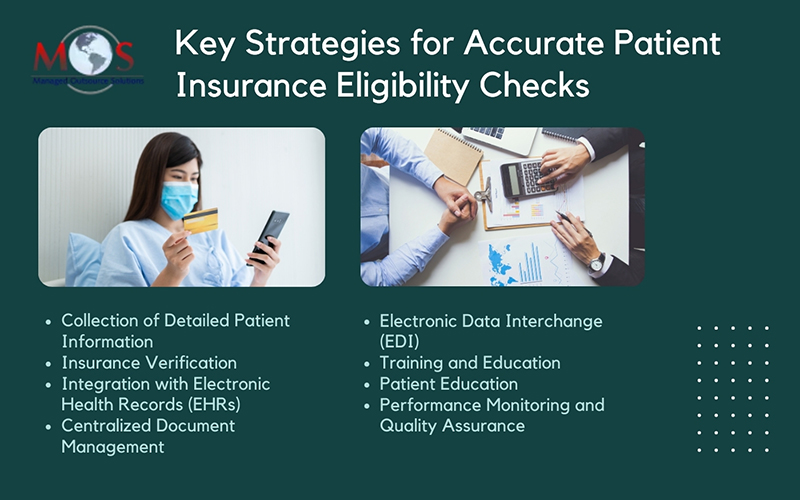Efficiency in the healthcare revenue cycle is influenced by three key components: the front-end, mid-cycle, and back-end processes. Of these, the front-end, which covers activities that occur prior to a clinical encounter, plays a critical role in driving revenue cycle efficiency. Front-end optimization in medical insurance verification is paramount for ensuring precise insurance checks, minimizing denials, improving patient satisfaction, and stabilizing cash flow.


Elevate your front-end processes with cutting-edge insurance verification services!
Front-end Best Practices for Accurate Insurance Eligibility Checks
Implementing best practices for verification of patient benefits can streamline your operations, minimize claim denials, and improve revenue cycle management.
Here are some key strategies for accurate patient insurance eligibility checks:
Collection of Detailed Patient Information
To initiate the patient eligibility verification process, it is essential to collect complete and accurate patient information during the registration or intake process. This includes demographic details, insurance policy information, primary and secondary insurance details, any relevant authorizations or referrals, and consent forms. Utilizing user-friendly digital patient intake forms can enhance data accuracy and reduce processing time. This ensures that the patient’s information is correctly entered into the system, enabling smooth verification and claims processing.
Insurance Eligibility Verification
Verifying a patient’s insurance coverage and benefits is essential to determine the extent of coverage for medical services. Front-end staff typically verifies insurance eligibility, confirms coverage details, and identifies any pre-authorization requirements to avoid claim denials and delays in reimbursement.
When it comes to communication with payers, companies providing insurance coverage checks often use a combination of methods, including making phone calls and utilizing insurance company web portals. Their professional team will call insurance companies to inquire about policy status, effective dates, co-payments, deductibles, prior authorization and any other pertinent information required for billing purposes. They may also use the company’s portal to quickly retrieve the necessary details online. In cases where information is not immediately available or requires clarification, as with complex insurance plans, specialists follow up with payers to resolve any outstanding issues.
Integrating real-time eligibility verification tools within the front-end systems can significantly improve efficiency. These tools allow instant access to insurance coverage details, co-pays, deductibles, and other relevant information. By verifying insurance eligibility upfront, you can identify any potential coverage issues or limitations before rendering services, reducing the risk of claim denials.
Integration with Electronic Health Records (EHRs)
Integrate eligibility verification directly into your EHR system. This strategy simplifies the process, enhances data accessibility, minimizes errors, and improves overall workflow efficiency. This will allow you to access real-time insurance information within the same platform where patient records are stored. It minimizes redundant data entry and ensures that billing information aligns with accurate and up-to-date insurance details. In addition to expediting administrative tasks it also facilitates a more fluid and patient-centric experience. With instant access to insurance information via the EHR, you can make informed decisions regarding treatment plans and financial arrangements before rendering services. This will reduce risk of claim denials and improve your revenue cycle.
Centralized Document Management
Efficient insurance eligibility verification requires detailed and accurate documentation. With a centralized document management system within your practice’s front-end workflow, you can ensure that insurance cards, authorizations, referrals, and other necessary documents are organized and readily accessible. This will promote smoother verification by reducing the chances of missing or misplaced documents.
Electronic Data Interchange (EDI)
Seamless and secure electronic communication between healthcare providers and insurance payers is essential for timely exchange of information on claim status, eligibility, and pre-authorization requests. By leveraging EDI capabilities, front-end systems can automate verification processes, eliminate paperwork, and reduce chances of errors. With real-time electronic data exchange you can improve your operational efficiency and help deliver more patient-focused care.
Training and Education
Front-end staff responsible for conducting patient eligibility verification in your practice must have a thorough understanding of insurance terminology, policy coverage specifics, and current regulatory mandates. Investing in extensive training and education for staff is essential to ensure accuracy. Regular training sessions and updates regarding industry developments enable staff to stay up to date on changes and carry out verification tasks with precision. Alternatively, engaging the services of a verification company will guarantee that skilled experts handle medical insurance checks, providing a cost-effective solution compared to investing in staff training.
Patient Education
Front-end staff can communicate crucial details to patients, covering things such as insurance coverage, financial obligations, and required documentation or prerequisites. Clear communication and patient education can help avoid potential misunderstandings and enhance compliance, streamlining the overall management of the revenue cycle.
Performance Monitoring and Quality Assurance
Implementing performance monitoring and quality assurance processes allows you to track the efficiency and accuracy of your eligibility verification efforts. Regular audits and reviews help identify bottlenecks, errors, or areas for improvement. By monitoring key performance indicators (KPIs) such as claim denial rates, verification turnaround time, and accuracy rates, you can identify trends and take corrective steps.
Boost Efficiency – Outsource Medical Insurance Eligibility Checks
Outsourcing the verification process will ensure it is handled by specialists in the field. By communicating clearly with payers, experts can help prevent misunderstandings, improve compliance, and facilitate smooth revenue cycle management. Implementing front-end workflows for efficient insurance verification services can ensure comprehensive data collection, optimize the process, minimize claim denials, and enhance overall operational efficiency.


Partner with us for seamless insurance verification and enhance your revenue cycle!






